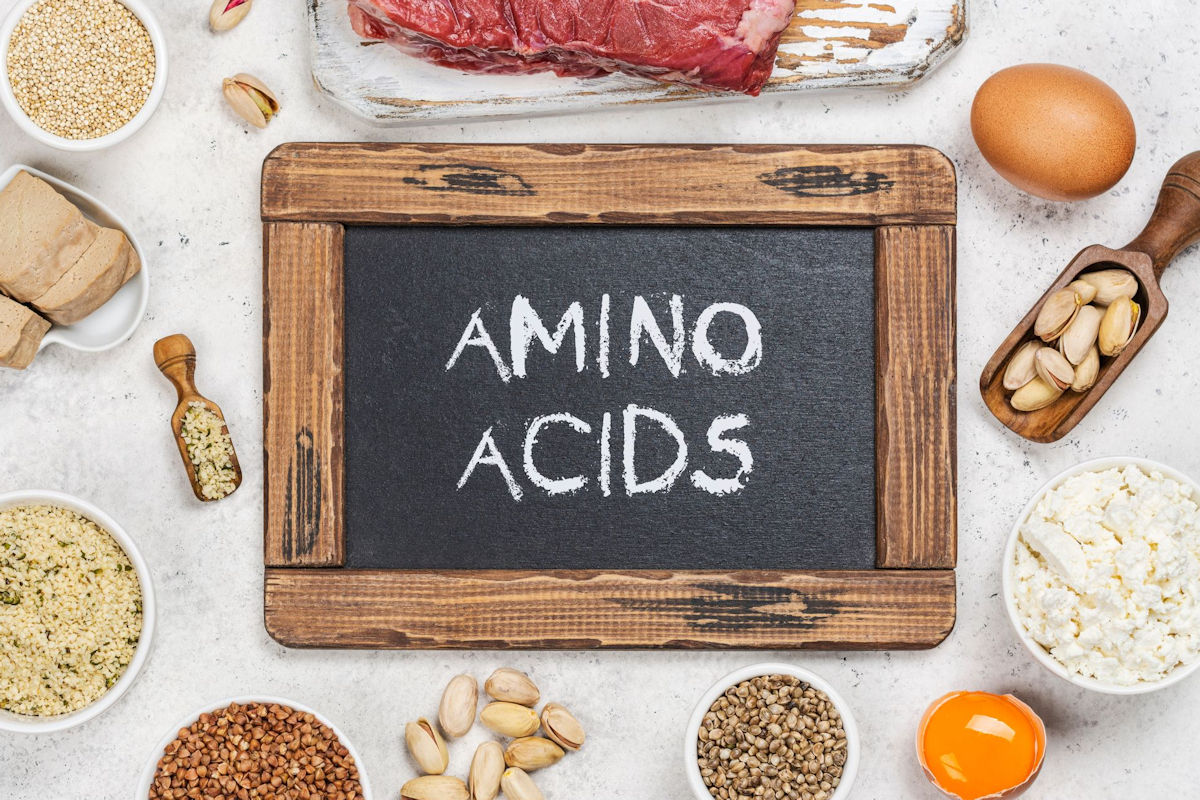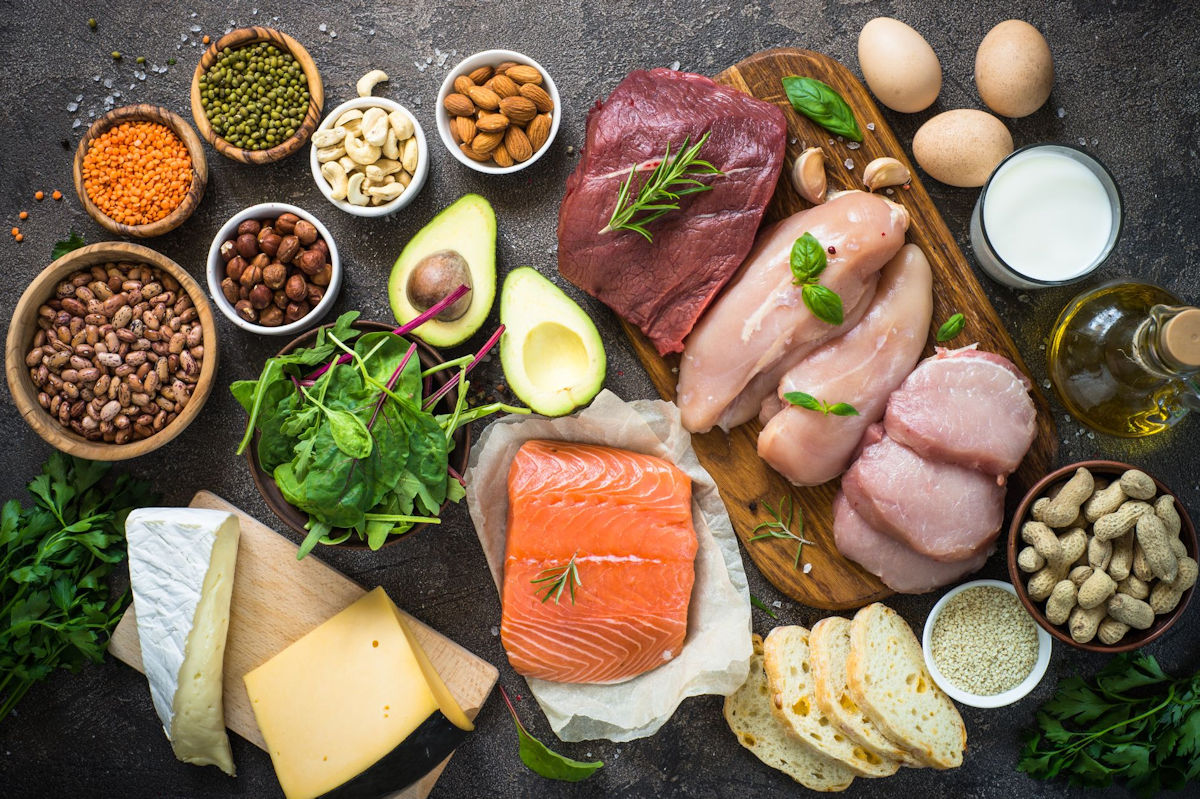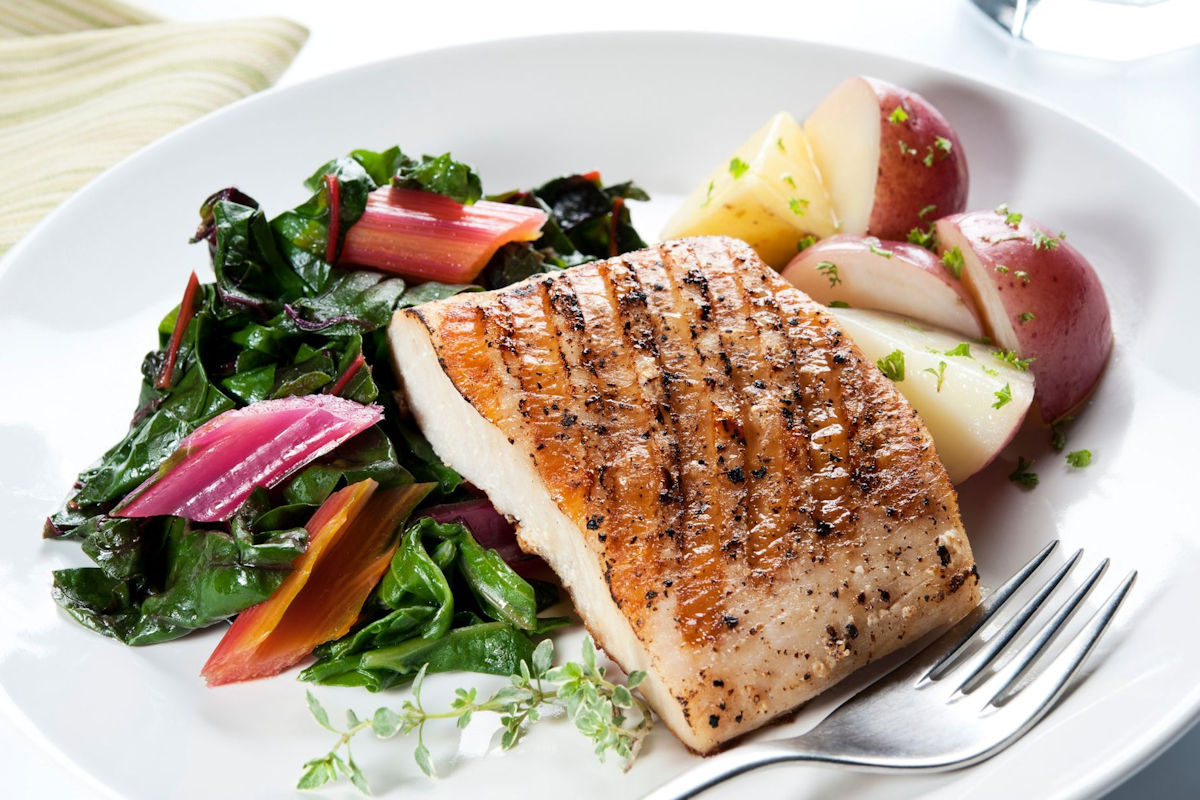If you’re looking to lose fat and get lean, getting enough protein is key.
Research shows that when you want to build more muscle and lose fat, aggressively cutting calories or entire food groups out of your diet is a recipe for disaster (1).
First, cutting too many calories is unhealthy and can stall your metabolism. It can also lead to nutrient deficiencies and muscle mass loss while leaving you weak, dizzy, and tired.
While we may lose weight with them initially, trendy diets that don’t fit into our lifestyle or leave us feeling deprived aren’t sustainable long-term.
What does work? Eating more protein.
Rather than banishing all carbs, studies show that shifting your focus to prioritizing eating more lean healthy protein, combined with a balanced diet and regular activity, is a better strategy for long-term weight loss (2).
In fact, a major reason many of us aren’t seeing the scale move or training is that we’re not eating enough protein. It can also keep us from continuing to build strength while training.
Combined with a balanced, healthy diet and regular activity, this is the way to go.
Why Is Protein So Important for Fat Loss and Weight Management?
There are two major reasons:
1. Protein Boosts Metabolism
Protein helps us build muscle. Muscle burns more calories than fat.
So having more muscle mass can increase the number of calories (energy) you burn even while resting, which is known as your basal metabolic rate (BMR).
Eating enough protein in combination with strength and resistance training can help us build more muscle.
How much muscle you put on takes time and depends on various factors, including age, gender, genetics, body size, and composition.
2. Protein Makes Us Feel Full
Protein is more satiating than carbs or fat.
When we eat protein, it triggers the body to reduce the “hunger hormone” ghrelin and instead boosts the levels of a hormone called peptide YY that makes you feel full.
So eating plenty of protein can affect the amount of food we eat overall.
The Digestion Of Protein Also Burns Calories
Our body requires energy to break down food into smaller, absorbable molecules our cells can use.
We know this process as the thermic effect of food.
Here’s what’s great about protein:
- 20-35% of the calories in the protein we eat get burned during digestion!
Only 5-15% of carbohydrate calories get burned during digestion, while fats are just 5%.
What is Protein Exactly?
Like fats and carbohydrates, protein is a macronutrient or “macro.” These nutrients our body uses in the greatest amounts.
When we eat protein, the body breaks it down into amino acids through the process of digestion.
Our cells then use amino acids for a variety of different important functions, including
- Growth and repair of tissues (like muscle)
- Production of enzymes and hormones
- Production of blood.
- Immune function
- Support of healthy hair, nails, and skin.
While there are over 500 amino acids in nature, the tissues of the human body need only about 20 to make all the proteins it requires (3).
Nine of these amino acids are essential, which means the body can’t make them on its own and we can only get them through the foods that we eat.
Healthy Fact: Not eating enough protein can cause muscle loss, dry skin, slowed metabolism, hair loss, and brittle nails (4).
What Are the Best Sources of Protein For Fat Loss and Building Muscle?
Protein is more satiating than fats or carbs.
Lean sources of protein have a lower fat and calorie content and are best for fat loss.
If you’re hungry shortly after eating, it’s your body’s way of telling you it needs more protein (5).
Here are some of the best sources of protein for weight loss
1. Meats (per 4-ounce serving)
The exact amount of protein in a serving of meat can vary depending on factors, such as the specific cut of meat and how it’s prepared.
These estimates should give you a good idea of the protein content of a 4-ounce serving of each type of meat.
- Turkey Breast = 30 grams of protein.
- Chicken Breast = 28 grams of protein.
- Lean Beef (filet, sirloin, or tenderloin) = 30-35 grams of protein.
- Lean Pork (tenderloin or loin) = 22-24 grams of protein.
2. Fish (per 4-ounce serving)
Besides being a great source of protein, fatty fish like salmon and sardines are also excellent sources of heart-healthy omega-3 fatty acids, which have been linked in studies to a variety of health benefits (6).
- Salmon = 25-30 grams of protein.
- Tuna (canned, in water) = 20-25 grams of protein.
- Cod = 20-25 grams of protein.
- Haddock = 20-25 grams of protein.
- Shrimp = 20-25 grams of protein.
- Scallops = 20-25 grams of protein.
- Halibut = 20-25 grams of protein.
- Sardines (canned, in oil) = 20 grams of protein.
3. Eggs
Incorporating whole eggs or egg whites into your diet can be a good way to increase your protein intake without consuming a lot of calories
Besides protein, eggs are also a wonderful source of other nutrients, such as vitamin D, vitamin B12, and choline.
Some studies show that eating eggs for breakfast may help promote feelings of fullness and reduce calorie intake later in the day (7).
- 1 Whole Egg, Large (80 calories) = 6 grams of protein.
- 1 Egg White, Large (17 calories) = 3.6 grams of protein
- 1 Egg Yolk (63 calories) = 2.4 grams of protein
Eggs are also super versatile!
- Use whole eggs to make omelets, and scrambled eggs or bake into muffin tins with veggies
- Eat hard-boiled eggs as a snack, sliced into salads, or on whole-grain bread
- Add liquid egg whites to smoothies or stir into oatmeal
If you’re concerned about the cholesterol in eggs, it’s important to note that recent research suggests that for most people, dietary cholesterol does not have a significant impact on blood cholesterol levels or heart health (8).
However, if you have high cholesterol or other health concerns, it’s always a good idea to speak with your doctor or a registered dietitian before changing your diet.
4. Dairy
Dairy is a great source of protein, and there are many low-fat and fat-free options available that can help you meet your protein needs while keeping your calorie intake in check.
- Plain Greek Yogurt (¾ cup) = 18-20 grams of protein.
Greek yogurt is a high-protein dairy style of yogurt and is also a good source of calcium and probiotics, which can benefit gut health.
Choose low or full-fat varieties which are more satiating than fat-free options.
- Cottage Cheese (½ cup) = 14-16 grams of protein.
Cottage cheese is also an excellent source of calcium and other nutrients like vitamin B12.
- Kefir (8 ounces) = 8-10 grams of proteins
Kefir is a fermented milk drink similar to yogurt but has a thinner consistency. It contains probiotics, which support gut health and immunity.
- Cheese (1 ounce) = 6-8 grams of protein (on average)
The exact amount of protein in a serving of cheese can vary depending on the type and brand. Cheese is also an excellent source of calcium and other nutrients.
If you’re working on fat loss, eat full-fat cheese in moderation since it’s high in calories.
- Whey Protein & Casein Protein (30 grams) = 20-30 grams per scoop
Whey and casein are two types of proteins found in milk that you can buy as supplements to support muscle growth and recovery. Add to smoothies, shakes, eggs, yogurt, and baked goods to boost their protein content.
Whey protein is a fast-digesting protein that’s absorbed quickly by the body, making it ideal for post-workout recovery.
Casein protein is a slow-digesting protein that’s absorbed more slowly, providing a sustained release of amino acids.
5. Legumes
Legumes, which include all beans, lentils, and peas, are an excellent source of plant-based protein. They are also high in fiber, which can help keep you feeling full and satisfied.
- Beans (½ cup) = 7-10 grams of protein
Beans of all kinds, including black beans and kidney beans, are versatile and nutritious! They’re high in vitamins and minerals, like folate, iron, and potassium.
- Lentils (½ cup) = 8-10 grams of protein
Lentils are available in many varieties, such as brown, green, and red lentils, and are also a healthy source of iron and other nutrients.
- Chickpeas (½ cup) = 7-8 grams of protein
Chickpeas, also known as garbanzo beans, are a good source of fiber, vitamins, and minerals, like folate and manganese. Use in dishes like hummus and falafel.
- Black-eyed peas (½ cup) = 6-7 grams of protein
- Peas (½ cup) = 4-5 grams of protein
Peas are a good source of fiber, vitamins, and minerals, like vitamin C and vitamin K. Add to soups and stews.
- Soybeans (1/2 cup) = 15-20 grams of protein
- Edamame (1/2 cup) = 8-9 grams of protein
6. More Plant-Based Options for Vegetarians and Vegetarians
- Soy milk (1 cup) = 8 grams of protein per cup
- Pea Protein Isolate (1 cup) = 15 and 20 grams of protein
Made from yellow peas, this one is a great substitute for dairy-based protein supplements. It’s often added to non-dairy milk options to boost their protein content.
- Tofu (3 ounces) = 7-9 grams of protein
Tofu, also known as bean curd, is a soy-based product that is commonly used as a meat substitute. It’s a good source of calcium and iron.
- Tempeh (3-ounce) = 11-15 grams of protein
Tempeh is a fermented soy product that has a firm texture and a nutty flavor and is also a good source of probiotics.
- Seitan (3 ounces) = 15-20 grams of protein
Seitan, also known as wheat meat, is a high-protein, meat-like food made from wheat gluten and is an excellent source of iron and other nutrients.
- Quinoa (1 cup) = 8 grams of protein
A delicious edible seed from South America with a grain-like texture, quinoa is a complete source of plant protein and folate, magnesium, and fiber.
Nuts and seeds, such as almonds, pumpkin seeds, hemp seeds, and chia seeds, are also wonderful sources of protein, fiber, antioxidants, and healthy fats with around 6-8 grams of protein per 1/4 cup.
They are high in calories, so if weight loss or maintenance is your goal, eat them in moderation.
The Benefits and Drawbacks of Different Protein Sources
When choosing protein sources, it’s important to consider the benefits and drawbacks of different options.
For example:
- Plant-based protein sources are typically lower in calories and higher in fiber than animal-based options. Not all plant-based sources provide a complete range of essential amino acids.
- Animal-based protein sources are often higher in calories and saturated fat, but are also typically more complete sources of essential amino acids.
It’s important to choose a variety of protein sources to ensure that you’re getting a complete range of nutrients and amino acids.
Tips for Incorporating Protein into Your Meals and Snacks
There are many easy ways to incorporate protein into your meals and snacks.
Here are some ideas to get you started:
- Add a scoop of protein powder to your smoothie or oatmeal.
- Top your salad with grilled chicken or shrimp and a scoop of beans.
- Snack on a hard-boiled egg or a handful of almonds.
- Dip raw veggies in hummus or Greek yogurt dip
- Make a batch of hard-boiled eggs at the beginning of the week for a quick and easy snack.
- Use legumes in a variety of dishes, such as salads, soups, and stews.
How Much Protein Do You Need Each Day?
The amount of protein you need depends on a variety of factors, including your body weight, activity level, and fitness goals (9).
Some experts recommend consuming up to 0.8-1 gram of protein per pound of body weight per day to support muscle growth and repair.
However, if you’re looking to lose fat and build lean muscle, you may need to increase your protein intake.
If You’re Sedentary: The recommended dietary allowance of protein for an adult is 0.8 grams per kilogram of body weight.
1 pound = 2.2 kilograms
That means a person weighing 150 pounds (68 kilograms) should eat at least 55 grams of protein per day.
If You’re Over the Age of 40: To avoid losing muscle mass (sarcopenia) your protein needs to increase to about 1–1.2 grams per kilogram. Or 60–80 grams per day for a 150 lb person.
If You’re Active: If you exercise regularly, you’ll also need about 1.1–1.5 grams of protein per kilogram.
If You Regularly Lift Weights or Are in Training: Aim for 1.2–1.7 grams of protein per kilogram.
If You’re Obese: You need to adjust your weight before calculating your needs to avoid overestimating and eating too much protein. Use this online calculator.
Consuming more than 2 grams of protein per kilogram of body weight per day has been linked to potential health risks, such as kidney damage and dehydration. (10)
Use These Online Tools
Use this online calculator to estimate your personal daily protein needs.
Or, download a food-tracking app like MyFitnessPal or MyPlate to calculate your protein requirements and help you keep track of your protein and nutrient intake each day.
You can also see a dietitian to help you develop a personalized plan for your goals.
Conclusion
To lose fat or maintain a healthy body weight, eating more lean protein during meals and snacks can boost metabolism and keep us more satiated, so we eat less.
The amount of protein we need to lose fat or maintain a healthy weight varies from person to person. Age, weight and activity levels are all factors to consider.
Consult with your doctor, healthcare provider, or nutritionist about how much protein you should be eating.




